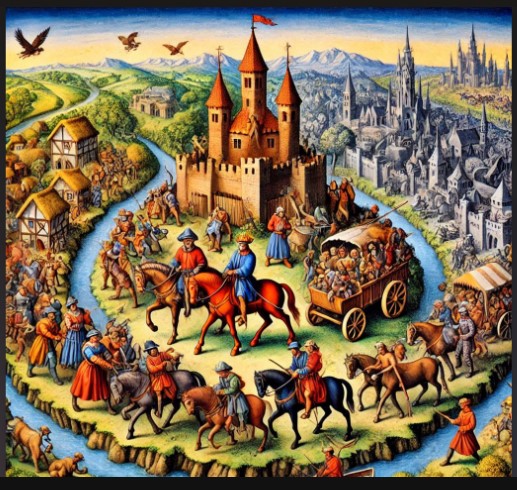Introduction to Feudalism
Feudalism, a dominant social, economic, and political system, emerged during the Middle Ages as a means to structure society around relationships derived from land ownership and service. At its core, feudalism was defined by a hierarchical order where land was exchanged for loyalty and service. This system became a cornerstone of governance in medieval Europe and parts of Asia, shaping societies for centuries.
Origins of Feudalism
The roots of feudalism trace back to the decline of centralized Roman authority. As the Western Roman Empire disintegrated in the 5th century, the need for localized governance and protection arose. Early forms of feudal relationships can also be observed in ancient societies, such as in pre-Medieval Germanic tribes and later in the Frankish kingdoms under leaders like Charlemagne.
Learn about Democracy
Structure of Feudalism
Feudalism operated on a well-defined hierarchy:
- Kings: Held supreme authority but relied on nobles for enforcing power.
- Nobles/Lords: Controlled vast estates and provided protection to their vassals.
- Knights: Served as the military class, offering protection in exchange for land or financial rewards.
- Serfs/Peasants: Bound to the land, they provided agricultural labor to sustain the economy.
This rigid hierarchy ensured stability but also perpetuated inequalities.
Characteristics of Feudalism
Several defining features shaped feudalism:
- Land Ownership: Wealth and power were tied to land rather than monetary wealth.
- Fealty and Vassalage: Vassals pledged loyalty and service to their lords in exchange for protection and land.
- Decentralization: Local lords wielded significant power, often surpassing the authority of the king.
Learn about Religiosity
Feudalism in Europe
Medieval Europe saw the pinnacle of feudalism between the 9th and 15th centuries. The system gained prominence following the collapse of Charlemagne’s empire, providing order amidst chaos. Key features included fortified manors, chivalry, and a strong bond between church and state.
Feudalism in Asia
In Japan, feudalism developed independently but shared similarities with its European counterpart. The samurai, akin to knights, served daimyos (lords) under the shogunate system. Despite differences in cultural contexts, the underlying principles of loyalty and land-based power remained consistent.
Economic Aspects
Feudal economies were predominantly agrarian. Landowners, through the manorial system, controlled production and trade. Serfs, tied to the land, worked in return for protection but had little autonomy, making the economy highly localized.
Social Aspects
Feudal societies were marked by rigid social stratification. Serfs lived under strict obligations, while nobles enjoyed privileges. Social mobility was limited, reinforcing long-term inequalities.
Feudalism and Religion
The Church played a pivotal role, often acting as a unifying force. Religious institutions owned vast tracts of land and were deeply entwined with feudal governance, legitimizing kings and influencing policies.
Learn About Humanism
Military System of Feudalism
Knights and lords maintained private armies, forming the backbone of feudal defense. The obligation to provide military service was integral to feudal contracts, shaping medieval warfare.
Decline of Feudalism
The decline of feudalism began in the late medieval period, driven by factors such as:
- The Black Death, which drastically reduced the labor force.
- The rise of centralized monarchies.
- Economic shifts due to the growth of trade and cities.
- Technological advancements in warfare.
Feudalism and the Modern World
While feudalism has largely disappeared, its influence persists in certain legal and societal structures. Concepts of loyalty, service, and decentralized governance can still be observed in some traditional communities.
Comparative Analysis
A detailed comparison reveals stark differences between European and Asian feudal systems, such as the cultural emphasis on honor in Japan versus the chivalric codes of Europe. Additionally, feudalism differs from modern systems like capitalism or socialism in its land-based hierarchy.
Examples of Feudalism
- Feudal England: The Norman Conquest of 1066 established a robust feudal framework, distributing land among William the Conqueror’s supporters.
- Japanese Feudalism: Under the Tokugawa Shogunate, Japan experienced a stable feudal order that lasted until the Meiji Restoration.
FAQs about Feudalism
- What is feudalism?
Feudalism is a hierarchical system of governance and landownership where lords granted land to vassals in exchange for loyalty and service. - When did feudalism begin?
Feudalism began around the 9th century in Europe, following the collapse of centralized Roman authority. - How did feudalism affect peasants?
Peasants, or serfs, worked the land for their lords and had limited freedom, though they were granted protection in return. - What led to the decline of feudalism?
Key factors include the Black Death, economic changes, and the rise of centralized monarchies. - How was Japanese feudalism different from European feudalism?
Japanese feudalism emphasized honor and duty, while European feudalism focused on chivalry and land-based wealth. - Does feudalism still exist today?
Feudalism as a system no longer exists, but its remnants can be observed in some traditional landownership practices.
Conclusion
Feudalism was a cornerstone of medieval societies, shaping their political, economic, and cultural landscapes. Understanding feudalism provides insights into the evolution of governance and societal organization, emphasizing its enduring relevance in history.
Societyopedia, A well known platform for the Social Sciences.


